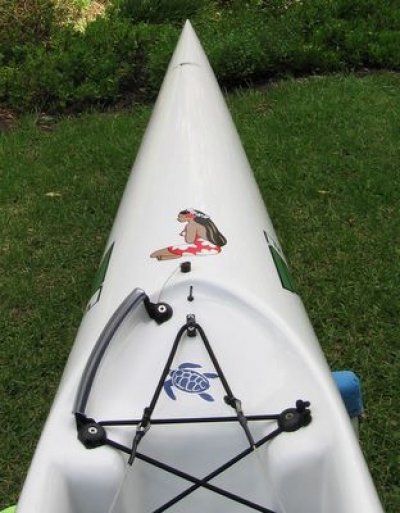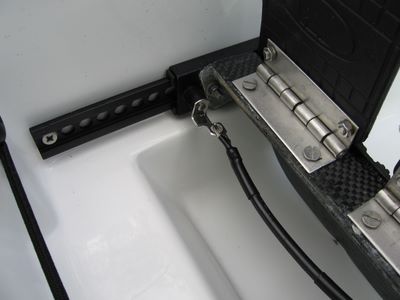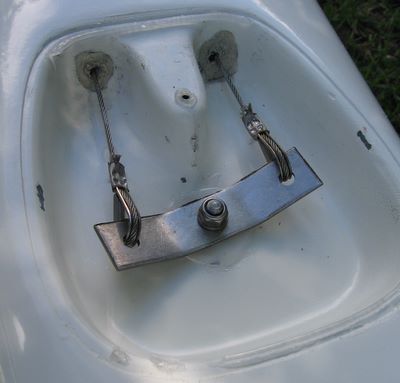Surfski.info Review: Fenn Mako Elite
 Fenn Mako Elite
Credits: www.surfski.info
Fenn Mako Elite
Credits: www.surfski.info
When I lost my beloved carbon Fenn Mako6 at the end of a disastrous downwind, I took the opportunity to order a new carbon Mako Elite from Keith Fenn. Hearing of my dire ski-less condition he delivered a new one very rapidly and I've been paddling it for the last couple of months.
Mako Elite v Mako6
The major differences between the Mako Elite and the Mako6 are:
-
Reduced rocker (some 3cm at the tail)
-
The rudder has moved some 10cm forward
-
The cockpit is located about 6cm further aft
-
Narrower hull by about 1cm
-
Taller foredeck by 1cm (which means the ski bag that I used to keep my Mako6 in is now too tight)
-
Slightly greater volume aft

Click here for a larger image.
Click here for a larger image.

Click here for a larger image.
Paddling the ski
Comfort
One of the reasons for my buying my Mako6 a couple of years ago was that for me it had the most comfortable seat of any ski on the market. This hasn't changed on the Elite. I don't like padding the seat up - and with the Fenn skis I don't have to, I can paddle all day with no sign at all of chaffing.
Flat Conditions
In summer we have a Tuesday Night Series in Hout Bay, and one of the last races this season took us out to Vulcan Rock - a vast round whale-like protuberance - located approximately 3km out in the Atlantic. It's a popular route giving a total distance of almost exactly 10km from start to finish.
We ground our way out to the rock into the prevailing light breeze and tiny ocean swells in long slipstreaming lines. I was at the back of one such line comprising six or so skis and my sights were set on one Nick Rocky (paddling an old Fenn Millenium) with whom I usually have a close dice. As we went around Vulcan Rock, Nick took an inside line and moved several skis ahead in the chain.
As we started back towards Hout Bay, I was still at the back of the line - but determined at least to catch up to Nick.
When I felt the back of the boat lifted by one of the small swells, I put my head down and accelerated - and found to my great gratification that I instantly gained almost a boat length on the next ski ahead. I tried repeating the trick on subsequent waves and each time it worked a treat. Within ten minutes I was not just past Nick, but I'd dropped the entire bunch.
Knowing that we wouldn't have even the meager assistance of these waves once we were back in the flat water of the protected bay, I went all out to put as much distance as I could between me and the chasing pack.
Suffice to say, my strategy worked and although Nick made a mighty effort to catch me, I held him off until we reached the beach and I just scraped onto a tiny shore wave to beat him.
Whether the ski is 2% or 5% faster than the Mako6 I couldn't say. But I am confident that in those conditions I would not have finished as well as I did in the Mako Elite.
Going Upwind
The Elite seems to be one of the quieter skis going upwind - with less rocker it should be faster and it certainly cuts through the waves cleanly and efficiently. I think the acceleration is better in comparison with the Mako6 too.
Millers Run - 9/10 hectic
Millers Point has two ramps where you can launch. The southern-most ramp is the one we normally use - Millers Point itself stretches out to sea on your left, downwind. If you fall off in really hectic conditions, you'll be blown down onto the rocks, landing through big surf. You really don't want to do this.
The second ramp is for wimps. It's on the northern, protected side of Millers Point. I've launched there a handful of times - usually when the wind has been so strong that you can see mini hurricanes swirling across the water lifting the spray off the surface.
This was one of those days. Running through my mind was the thought that the ski was brand new - this was literally the second time I was taking it out. I was also a) still unsure whether it was more or less stable than the Mako6 and b) absolutely sure that I didn't want to damage it. So we launched at the wimp-ramp.
What I hadn't factored in though was that the wind was blowing more southerly than south-easterly - and the result was that it was swirling off the cliffs and for the first two km of our paddle, was blowing directly offshore. Soon we were paddling down massive breaking 6-9 foot swells - with a 30kt+ crosswind.
I was paddling with Charles Brand, who was in his trademark V10 Sport. Charles is a highly competent paddler - but I do usually beat him, especially downwind! But for that first stretch, while we battled through the crosswind, he was leaving me behind. In his stable Sport, he was able to continue paddling more or less as normal, while I was feeling exceptionally exposed and tentative.
As we got further from shore, however, the wind swung back to a SSE direction and I became more and more confident and was soon enjoying myself again. But it was highly instructive - a paddler on a more stable ski will walk away from a paddler in a faster ski if that paddler is battling with stability.
Lots of other Millers Runs
Since then I've probably done a dozen more Millers Runs of varying intensity.
This ski is superb downwind.
During 2008, I had a long break from my Mako6 while I paddled a Red7 Surf70 Pro, a V10 Sport Ultra and a Synergy Lite. When I started paddling my Mako6 again I found to my distress that I'd become used to some of the characteristics of the other skis that I now felt lacking in the Mako6.
I found that the Mako6 was not as maneuverable on the runs as some of the other skis - and had a tendency to broach. This culminated in my losing control and ramming a buddy during a particularly hectic Millers Run. (Elite paddlers tend to look blankly at me when I talk about broaching - but this tendency was confirmed by several other paddlers of similar in ability to me in our Millers Run group.)
I also found it difficult to attack the "next wave". More often than not, the ski would wallow into the wave and I'd have to wait for the wave behind before I could pick up speed again.
In comparison with the Mako6, I find the Elite:
-
Picks up the runs more easily.
-
Stays on the runs longer.
-
Doesn't nose-dive.
-
Is much more responsive to the rudder, especially when you're looking for the next dip in the water
-
And can be accelerated over that "next" wave crest.
In short, for me at any rate, it's a much faster ski in downwind conditions. This is borne out by my times for the Millers run in comparison with my paddling buddies.
Tippy or not?
To be more explicit - is the ski tippier than the Mako6?
There's no doubt the ski feels different and for me it is marginally tippier. The time I notice it most is, you guessed it, on the way out to the rock at Millers Point in fierce side-wind and big side-on seas.
Would I be happy to paddle it in a big Molokai? It's probably accurate to say that at this point I'm not sure. But at least partly because of the comfort of that seat, I feel more secure in the Mako Elite than I do in the V10 Ultra where I have to use a bum pad to stop my coccyx from rubbing raw.
I haven't had a chance to paddle the Elite again in a really intense Millers Run and now that autumn is here, it's unlikely that I'll get that chance again before next summer.
Remounting the ski
When I borrowed Dawid Mocke's Mako Elite last year I did two 7/10 hectic Millers Runs and fell out on both of them. I found straight away that a bum-first remount is especially difficult because of the deep, narrow cockpit. But both times I found the straddle remount fairly easy and got back in first time on both occasions.
In terms of ease of remount therefore - I'd give it a 7/10. (Epic V10: 7/10; Synergy: 8/10; Red7 Surf70 Pro: 9/10)
Build Quality
My ski weighed in at around 12.7kg, (28lb). My Mako6 was over a kg lighter - but I broke it in small surf in Durban when it was still brand new (It was still in one piece - just - and after the accident and I shipped it back to Fenn Kayaks and it was returned about 400g heavier after a beautiful repair job). So I'll settle for another kg if it means a stronger boat!
The ski has a foam stringer that provides a measure of floatation in the event that the ski's hull floods. This has proved a lifesaver on more than one occasion (for example, click here).
Hull and Deck
The hull and deck have a beautiful finish - not quite the mirror-like finish of some of the Chinese boats, but still excellent. The fittings are more functional than beautiful.
Footplate & rudder pedal assembly
I was disappointed to find one of the rudder pedals was mounted inaccurately and I found myself filling the hole and re-drilling it in order to have the rudder pedals line up. This problem seems endemic - Dale Lippstreu's new double had exactly the same problem. The employee at Keith's factory responsible for the footplate and rudder pedal assembly needs a mighty kick up the backside. (Update: I learned a few days ago that the whole rudder plate assembly is being redesigned and this problem won't exist in future.)
Rudder
The rudder box cover had been sealed onto the boat with silicon sealant. This seems bizarre as the first thing you have to do is remove the cover in order to install the rudder!
When I installed the rudder, two problems became apparent. The tiller bar locates onto the rudder shaft by means of machined bevels. This had also been manufactured inaccurately and I found that the tiller bar ended up about 5 degrees out of true. This has minimal practical consequence since one seldom uses full rudder - but it does mean the rudder turns about 5 degrees more on one side. I'd term this aesthetically irritating rather than a major issue. The second problem was that the leading edge of the rudder was showing foam core - implying that it hadn't sealed and would be prone to damage. Sure enough on one of my first Millers runs I hit some kelp and the rudder more or less disintegrated. Tape held it together until I could get a replacement.
In summary - the ski itself is built beautifully but the devil definitely got into the details of this one.
Carbon skis and dings
While the ski is definitely extremely rigid, it's well known that the carbon foam sandwich used is susceptible to puncture damage and dents easily. I have a set of cradles and I'm careful not to put the ski down on hard surfaces where possible.
Setting the ski up
The rudder pedal adjustment requires use of an Allen Key. It's not as convenient as the automatic adjustment used on several of today's skis (Red7, Custom Kayaks, Epic, Think, Knysna Kayaks) but it's a simple, reliable solution. And after all, once you've set the ski up, how often are you going to move the footplate anyway?
What I like about the carbon Fenn Mako Elite
-
The comfort: the seat fit makes me feel secure as well as comfortable. I feel like I'm putting the ski on when I get into it!
-
The steering: despite having an identical rudder, the ski steers much more positively in waves than the Mako6
-
The downwind performance: in my opinion the ski catches runs more quickly than the Mako6; stays on them longer and makes it easier to ramp over the "next" wave.
What I dislike
-
The "soft" skin: the carbon/foam sandwich skin is prone to dents and puncture damage. But I'll live with it in order to have a stiffer, lighter ski. (But heck, all the light boats are susceptible to damage; I'd use my cradles with any of them!)
Overall
I find the Mako Elite a significantly more rewarding ski to paddle than the Mako6. It well deserves its reputation of being one of the best all-round skis available today.
Fenn Kayaks Website
Fenn Kayak's minimalist site is at http://www.fennkayaks.co.za/




